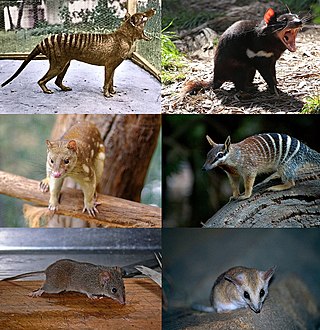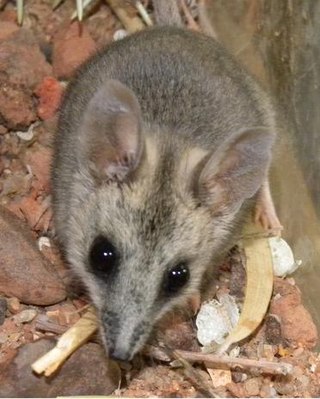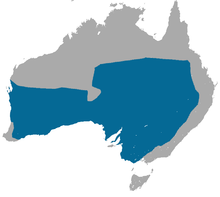
The thylacine, also commonly known as the Tasmanian tiger or Tasmanian wolf, is an extinct carnivorous marsupial that was native to the Australian mainland and the islands of Tasmania and New Guinea. The thylacine died out in New Guinea and mainland Australia around 3,600–3,200 years ago, prior to the arrival of Europeans, possibly because of the introduction of the dingo, whose earliest record dates to around the same time, but which never reached Tasmania. Prior to European settlement, around 5,000 remained in the wild on Tasmania. Beginning in the nineteenth century, they were perceived as a threat to the livestock of farmers and bounty hunting was introduced. The last known of its species died in 1936 at Hobart Zoo in Tasmania. The thylacine is widespread in popular culture and is a cultural icon in Australia.

Dasyuromorphia is an order comprising most of the Australian carnivorous marsupials, including quolls, dunnarts, the numbat, the Tasmanian devil, and the extinct thylacine. In Australia, the exceptions include the omnivorous bandicoots and the marsupial moles. Numerous South American species of marsupials are also carnivorous, as were some extinct members of the order Diprotodontia, including extinct kangaroos and thylacoleonids, and some members of the partially extinct clade Metatheria and all members of the extinct superorder Sparassodonta.

The Dasyuridae are a family of marsupials native to Australia and New Guinea, including 71 extant species divided into 17 genera. Many are small and mouse-like or shrew-like, giving some of them the name marsupial mice or marsupial shrews, but the group also includes the cat-sized quolls, as well as the Tasmanian devil and the extinct thylacine. They are found in a wide range of habitats, including grassland, underground, forests, and mountains, and some species are arboreal or semiaquatic. The Dasyuridae are often called the 'marsupial carnivores', as most members of the family are insectivores.

Torpor is a state of decreased physiological activity in an animal, usually marked by a reduced body temperature and metabolic rate. Torpor enables animals to survive periods of reduced food availability. The term "torpor" can refer to the time a hibernator spends at low body temperature, lasting days to weeks, or it can refer to a period of low body temperature and metabolism lasting less than 24 hours, as in "daily torpor".

Dunnart is a common name for species of the genus Sminthopsis, narrow-footed marsupials the size of a European mouse. They have a largely insectivorous diet.

Mulgaras are the six small rat-sized species in the genus Dasycercus. They are marsupial carnivores, closely related to the Tasmanian devil and the quolls, that live in deserts and spinifex grasslands of arid Australia. They are nocturnal, but occasionally "sunbathe" in the entrance of the burrow in which they dwell. Their kidneys are highly developed to excrete extremely concentrated urine to preserve water, as the animals rarely drink. They feed mostly on insects, but also eat reptiles and small mammals. They are seasonal breeders and breed from June to September. The pouch comprises two lateral folds of skin.

Antechinus is a genus of small dasyurid marsupial endemic to Australia. They resemble mice with the bristly fur of shrews.

The kultarr is a small insectivorous nocturnal marsupial inhabiting the arid interior of Australia. Preferred habitat includes stony deserts, shrubland, woodland, grassland and open plains. The kultarr has a range of adaptations to help cope with Australia's harsh arid environment including torpor similar to hibernation that helps conserve energy. The species has declined across its former range since European settlement due to changes in land management practices and introduced predators.

The subfamily Sminthopsinae includes several genera of small, carnivorous marsupials native to Australia: kultarrs, ningauis, dunnarts, and planigales.

Smintopsini is a tribe of marsupial in the family Dasyuridae.

The slender-tailed dunnart, also known as the common dunnart in Australia, is a dasyurid marsupial. It has an average body length of 7 to 12 centimeters (2.8–4.7 in) with a tail length of 5.5 to 13 centimetres (2.2–5.1 in). It weighs 25–40.8 grams for males and 16.5–25.4 grams for females.

The striped-faced dunnart is a small, Australian, nocturnal, "marsupial mouse," part of the family Dasyuridae. The species' distribution occurs throughout much of inland central and northern Australia, occupying a range of arid and semi-arid habitats.

The white-tailed dunnart, also known as the ash-grey dunnart, is a dunnart native to Australia.

The Julia Creek dunnart is a marsupial with a buffy brown upperside and white underside. This dunnart has a body length of 100–135 mm with a tail of 60–105 mm to make a total length of 160–240 mm. Its weight is between 40 and 70 g. The length of the hind foot is 22–24 mm. The species has a dark brown triangle colour from above and below the eye with the point at the nose, and another dark stripe on top of the skull. A healthy dunnart has a carrot-shaped tail filled with fat stores.

The fat-tailed false antechinus, also called the fat-tailed pseudantechinus and red-eared antechinus, is a member of the order Dasyuromorphia. It is an inhabitant of western and central Australia. Its species name, macdonnellensis, refers to the MacDonnell Ranges near Alice Springs, where it was first discovered.

The New Guinean quoll, also known as the New Guinea quoll or New Guinea native cat, is a carnivorous marsupial mammal native to New Guinea. It is the second-largest surviving marsupial carnivore of New Guinea. It is known as suatg in the Kalam language of Papua New Guinea.

The sandhill dunnart is a species of small carnivorous Australian marsupial of the family Dasyuridae. It is known from four scattered arid areas of Australia: near Lake Amadeus in Northern Territory, the central Eyre Peninsula in South Australia, the southwestern edge of the Great Victoria Desert in Western Australia, and at Yellabinna in South Australia.


















